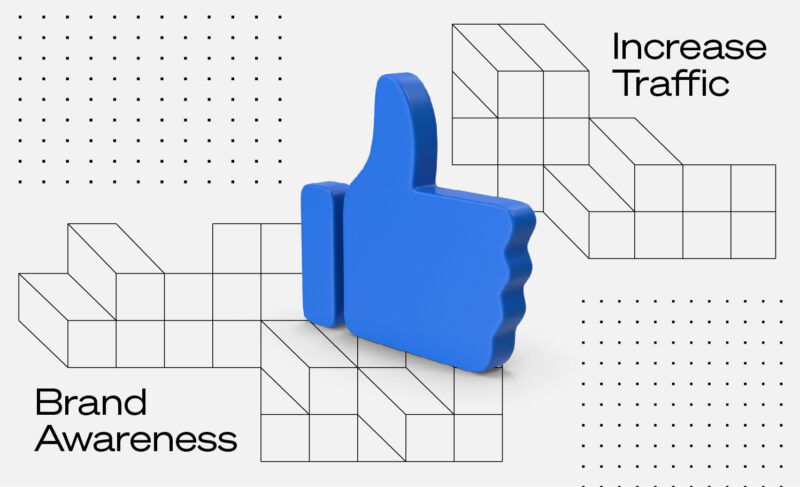Related Services
Credits
Writer: Dejan Kvrgic

The digital era is a time of fast-moving technology and hard-to-predict consumer behaviors and interests.
Marketers have a tough digital-marketing-nut to crack, even more so now, when almost every facet of business has been fundamentally changed and reset by the global health crisis. Maintaining a competitive edge requires marketers to be up-to-date with the changing marketing landscape and adjust their marketing efforts to new and emerging trends. What Internet marketing trends can be expected in the future, and how can your business respond to them?
The Future Of Digital Marketing & Trends That Will Shape Your Marketing Strategies
As extraordinary as 2020 was, it was a wake-up call for businesses who were struggling to stay on top of their long-term digital marketing strategy. Making a solid short-term marketing plan also means keeping an eye on where you’re headed in the long-term.
Digitally-first brands that already worked on building a strong online presence outperformed the rest when the pandemic hit. Last year prioritized agility, resilience, and swift responsiveness to changes in consumer behavior.
As the entire world enters the second year of a global health crisis, we cannot ignore one question:
What Internet marketing trends can we expect to see in the future?
It’s impossible to say what the future of online marketing will look like with absolute certainty, even with the research, statistics, and patterns in data available to us. However, it’s evident that when the COVID-19 pandemic forced the entire world indoors, it had a dramatic and potentially lasting impact on businesses and consumers alike.
With that in mind, we will outline the defining digital marketing trends that will help your business move one step closer to the pinnacle of marketing – sending the right message to the right consumer at the right time.
#1 Personalized Effort Over “Batch-And-Blast”
The shift toward marketing personalization is hardly new or revolutionary. It’s been at the forefront of Internet marketing strategies for at least a decade now.
The transition from generic, batch-and-blast email marketing to more dynamic and individualized interactions is the first step toward better customer experiences and brand loyalty. However, what we’re talking about in terms of trends that will shape digital marketing in 2021 goes beyond writing better email subject lines.
Research indicates that 90% of consumers value personalization, with up to 80% of them being more open to doing business with a company that offers a personalized experience.
Create A Tailor-Made Customer Experience
What businesses should strive to achieve in the future is an individualized, tailor-made customer experience that will stand out in the noisy digital world. Win over your customers’ hearts by taking some time to identify what they want and when they want it; simple as that.
You need to hyper-target your exact customer. Otherwise, your brand’s message will fall right through the cracks and go unnoticed. Past year’s events further underlined this need for a highly personalized approach to marketing.
Show your understanding of what the consumers’ “new normal” is, learn what makes them tick, and use that knowledge to create a more relevant customer experience. A little effort can yield amazing results in increased engagement, brand loyalty, and conversion rates.
You’re already collecting massive amounts of data. So, you might as well leverage machine learning and artificial intelligence in a meaningful way and hyper-personalize every aspect of the customers’ journey.
#2 Video Is King In Content Marketing
One pandemic and several lockdowns later, people’s boredom levels have reached new highs – and as boredom levels went up, so did the social media consumption. People have turned to social media platforms, including Facebook, Instagram, and TikTok, and messaging apps for entertainment.
That’s where we get to one of 2021’s hottest content marketing trends – short-form video. It’s catchy, attention-grabbing, and instantly engaging and applicable to any given stage of the customer journey. Although still as relevant as ever, text-based content marketing can’t compete with the power of video.
Content marketing spans multiple channels, from email to video, but it’s the latter that holds the title of one of the most effective means of delivering your brand’s message. And as such, video marketing should be one of the key priorities for a business looking to grow its online presence and engagement.
If your business still hasn’t worked out the best approach to video marketing, 2021 is the year to get started.
Go Beyond YouTube
Your mind probably jumps straight to Google-owned YouTube, one of the most popular video-sharing platforms and the second-largest search engine. However, Twitch and TikTok are giving it a run for its money – and so is live video, as one particularly compelling form of content. The “live” element makes videos even more engaging and attractive to consumers, tapping into their fear of missing out on news and tidbits of information about your business.
#3 Embracing Artificial Intelligence (AI) In Practice
The growing interest in artificial intelligence and advancements in AI-powered technology over the past few years have made one thing clear:
If they want to keep up with the competition, brands have to consider how they can utilize AI as part of their digital marketing and business strategies.
One particular area of your business’ online presence where artificial technology and automation may bring significant changes for the better is customer service. Chatbots might be the next big thing, and given the idea of customer care that must never sleep – a side-effect of the digital revolution – it’s all too easy to see why.
A staggering 50% of customer queries are already managed via AI-based website chatbots. Predictions regarding AI-first strategies being the new normal in digital marketing and customer service by 2025 don’t seem too far off right now.
However, make sure that your business doesn’t rely on chatbots for handling customer relationship management (CRM). The idea behind this technology is to enhance your marketing efforts, not replace your employees and one-to-one communications entirely. The hands-on approach to marketing with a touch of “human” to it is still as essential as ever.
Chatbots & Real-Time Conversational Marketing
You might think of chatbots as nothing more than mildly annoying, borderline dumb pop-ups on a website’s landing page. That’s where you’re wrong. AI technology might still be in its infancy, but automated conversational marketing is getting a lot smarter, all thanks to artificial intelligence advancements.
The future of digital marketing trends is clear; adopting a conversational approach and facilitating one-on-one, real-time connections across a broad spectrum of channels should be your company’s primary marketing strategy.
Meet customers on their terms – their device, their schedule, and their preferred messaging apps. Most importantly, keep the communication lines open; in a world driven by instant gratification, customers expect nothing short of an immediate response.
One-on-one communication, customer service, and transaction, intertwined into one and available 24/7; this is conversational marketing at its best.
#4 Voice Search Is Gaining Traction
“Alexa, what digital marketing trends can marketers expect to see in the future?”
Increased use of voice assistants like Alexa, Siri, and Google and demand for website integration of voice search capabilities urge marketers to rethink their digital marketing strategies in 2021.
“Adopting a voice search strategy isn’t just about remaining relevant – it’s also about creating a unique and optimized customer experience that will foster relationships and build brand loyalty.”
Yes, it poses several challenges in terms of website and content optimization, but it also brings forth exciting opportunities. It’s no wonder marketing experts are betting on voice search as the future of online marketing.
Even if your company is not ready to take on smart speaker advertising, the technology can still work to your advantage and spread brand awareness. Make sure to optimize your website for voice search and longer, more conversational queries, with valuable content that will address the customer’s search term directly and using natural language.
However, your primary goal with voice search shouldn’t be forcing your brand messaging and sales. Instead, marketers should view it as a medium for creating a more “connected” user experience and a unique, contextual approach to consumer interactions.
#5 Interactive Content Marketing & Immersive Technologies
Blog posts and video content remain vital for driving traffic to your business’ website, but they’re not the out-of-the-box thinking and innovation that people crave. If you want to grab consumers’ attention and make your business stand out in the crowd, look beyond the traditional means of content marketing and start exploring the world of immersive technologies. That’s where virtual reality (VR) and augmented reality (AR) emerge as clear leaders in one of the fastest-growing digital marketing trends to date – the shift from visual to interactive content.
The virtual reality market was valued at more than $15 billion in 2020, and the COVID-19 outbreak has caused a virtual technology boom; this trend is predicted to grow even further in the upcoming years. That said, augmented reality stands out as far more implementable from a digital marketing standpoint and will continue to outpace VR in terms of marketing share.
Given the growing popularity of interactive experiences, businesses are encouraged to consider how they can incorporate augmented reality (AR) into their current digital marketing assets. You want to offer your customers a fully immersive experience, interactive, and personal experience? Start learning about and exploring the idea of AR as part of digital engagement. Your competition might already be on it.
#6 Nano Influencer Marketing
Influencer marketing is anything but new. It’s already grown by leaps and bounds and, based on recent estimates, is only going to get bigger:
It is set to become a $15 billion industry by 2022; 63% of marketers aim to increase their influencer marketing budget in 2021.
A person with a significant social media following and, in turn, a notable influence within these social media platforms promotes your products and services to their followers. The concept has been around for a while and has proven to be a highly effective digital marketing strategy.
A New Approach To Influencer Selection
What’s emerging as a new trend in influencer marketing is the shift in focus. Brands are directing their influencer selection toward a new category – Nano influencers, people with 10,000 followers or fewer.
After a year like 2020, which underlined the need for marketing strategies that resonate with people stuck at home, this shouldn’t come as a surprise.
Influencers with fewer followers tend to have higher engagement rates, forming deeper, one-on-one connections with their audience on social media such as Facebook and Instagram. They are more often perceived as a “friend” or the “guy next door” rather than an Internet celebrity.
People value authenticity and close interactions through social media, even more so at a time like this. That is what these smaller-but-natural, authentic accounts, and their enthusiastic audiences, bring to the table.
It seems counterintuitive, but Nano influencers provide brands with more social media exposure on Facebook and Instagram. The secret, again, is in higher engagement rates. Despite having fewer followers, the so-called Nano influencers forge loyal followings and create intimate interactions.
The financial aspects of this digital marketing trend shouldn’t be overlooked, either. Nano influencers tend to run their channels by themselves and are more open to non-monetary compensation, meaning negotiating collaborations is more cost-effective.
#7 Big Data & Deep Learning Applied To Marketing
Big Data empowers marketers to take on a more granular approach to digital marketing, making it possible to identify their target market – people who are likely to be interested in their services and products. However, it’s important to note that Big Data is, in a way, a double-edged sword.
The Internet of Things continues to grow more powerful, and companies continue to collect vast quantities of data through people’s mobile phones, computers, wearable technology, smart TVs, and even home appliances.
From a digital marketing perspective, this overwhelming amount of data is a huge advantage. It allows the marketing industry experts to get deeper insights into consumer behaviors, such as the purchase patterns and buyer intent, and leverage it to better position their services and products.
But it also underlines the growing need for transparency in how this consumer data is being collected and processed, sparking a global revolution on data privacy.
You have to make sure that your marketing strategy strikes a happy medium, offering a personalized customer experience without overstepping those privacy boundaries.
Deep Learning, A Game-Changer For Marketing Analytics
Chatbots and conversational marketing are only part of the picture. Deep learning, a subset of machine learning, extends AI’s applications even further and hints at digital marketing trends’ duality. On the one hand, there’s creativity, and on the other, there’s a technology- and data-driven approach to developing a marketing strategy.
Decisions and tasks that people could previously process can now be handled through deep learning – employing “neural networks” to mimic the human brain. Since the computer can process massive amounts of data, it can tackle these tasks and problems and learn new skills significantly faster than humans, allowing for predictions and analysis on a mass scale.
How does this apply to digital marketing?
Deep learning is already applied to marketing automation solutions and customer interaction tools. Chatbots that use Natural Language Processing (NLP), speech recognition, Real-Time Bidding (RTB) software, and hyper-personalization in email campaigns all rely on deep learning to a degree. But it’s the ability to analyze big databases for patterns and insights about your target audience that enables a huge leap forward digital-marketing-wise.
#8 User-Generated Content (UGC)
User-generated content, or UGC, has been present for some time now as one of the more compelling forms of content. But in the year ahead, after the COVID-19 pandemic kicked things into high gear, it seems more important than ever:
Businesses were forced to rethink their digital marketing strategy due to mandatory closures and lack of resources for full-scale marketing campaigns. User-generated content became a pivotal part of online marketing.
Reports about consumer behaviors indicate that UGC influences purchase decisions more than any other form of advertising. Customers will trust other customers far more than they trust a business, meaning they will turn to user-generated content.
Social media, like Facebook and IG, backed by messaging apps, gave life to “communities” of like-minded people linked by common interests and experiences. And user-generated content strengthens this sense of community among customers.
It’s relatable, it brings brands and customers together, deepening the sense of belonging, and it taps into the human desire for connection. It sends a simple but important message: We’re all in this together.
User-Generated Content & Storytelling
Above all else, user-generated content is a powerful storytelling tool. Your company can meet your customers where they already spend a good portion of their time and let them be in charge of generating content. Comments, testimonials, photos and videos of your products or services, and employees who share personal brand-related experiences; UGC is a potent tool, both in user experience and your website’s SEO. User- and employee-generated content is a fluid marketing strategy that can build the brands’ online presence, boost engagement, and drive conversion rates in the most relatable way possible.
#9 Search Engine Optimization (SEO)
Search engine optimization (SEO) has always been a moving target for marketers and business owners alike. Google continues to push out search algorithm updates, keeping things in a constant state of flux and evolution. Take November 2019 updates to Google’s search algorithms, for example. It was a rather busy month for Google, marked by the new BERT system’s launch, designed to help Google understand the natural language in long-tail search queries and improve the search results’ relevance.
Due to the changes in search engines’ use and browsing behaviors and the growing demand for easy-to-access information, “being number one” no longer means ranking first on SERP. “Position zero” seems to be the new business objective. Brands are still trying to figure out how to take the right-at-the-top, above-organic-listings position on a search engine results page – the coveted “position zero” – as it requires a different SEO approach. If you beat your competition to it, you’ll be at a significant advantage.
The bottom line is that SEO continues to top charts as one of the crucial pillars of online marketing. However, marketers are witnessing one of the most significant shifts in the SEO industry in the past decade and one that promises to be more than a mere nine days’ wonder. Search engines are getting smarter, and SEO is evolving. Keep an eye on the trends and practices in SEO to optimize your website in the best possible way, making user intent your top priority.
#10 Virtual Events
Virtual events are the new normal. What started as a necessity in the face of the COVID-19 pandemic became more of a commonplace.
“Now more than ever, event planners and organizations need to lean on the virtual method of conducting events.”
– Ben Erwin, President of PSAV
Many businesses have realized that moving their events into the virtual space opens them entirely to new, previously “unreachable” audiences. Engaging with a broader set of customers, without the limits of social distancing, travel, and geography, took accessibility to a whole new level. Higher attendance and more participants due to hard-to-beat accessibility, coupled with the fact that planning and executing a virtual event generally costs less than an in-person one, meant a higher ROI. That’s common sense.
But even as the pandemic subsides and in-person events return to the stage, more than 80% of businesses across multiple industries plan to give virtual events a permanent spot in their future marketing strategies. In short, virtual events are here to stay.
The New Event Format Has Its Challenges
Businesses need to avoid slipping back into the old, one-way communication street as they move into a virtual setting. With the main channel being a virtual one, falling into the trap of talking at rather than with the consumers is easy, even more so when the event is broadcasted rather than live.
One might argue that live virtual events carry with them a higher chance of “complications.” However, the pay-off is, for the most part, more significant than the actual risks: Live virtual events bring the consumers what they crave most – an experience that, at least to a degree, mimics the now prohibited in-person events.
The Bottom Line
In terms of what Internet marketing trends can be expected for the future, it seems that digital marketing will find itself knee-deep in evolving technology and automation, SEO tactics, and strategies. COVID-19 pandemic only kicked things into high gear and highlighted the need for innovation and adaptability to the rapidly evolving marketing world.
Change is an integral part of the business world. Online marketing trends will come and go, but the bottom line is:
Identify your target audience, make them feel heard, and develop customer-focused content to solidify these business-customer relationships. Put people first, at the core of everything you do.
That’s why at Pastilla, we always look beyond ads and links. Our marketing and branding approach is more strategic, analytical, and data-driven – and above all, people-centric.


